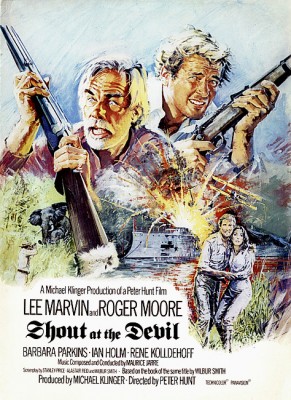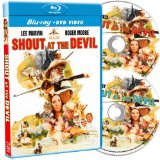| Reviews & Columns |
|
Reviews DVD TV on DVD Blu-ray 4K UHD International DVDs In Theaters Reviews by Studio Video Games Features Collector Series DVDs Easter Egg Database Interviews DVD Talk Radio Feature Articles Columns Anime Talk DVD Savant Horror DVDs The M.O.D. Squad Art House HD Talk Silent DVD
|
DVD Talk Forum |
|
|
| Resources |
|
DVD Price Search Customer Service #'s RCE Info Links |
|
Columns
|
|
|
Shout at the Devil
The movie is a big scale adventure film with almost non-stop action, but adopts a seriocomic approach that doesn't really work. Nevertheless, Marvin and Moore are fun to watch, and both the movie and Timeless Media Group's Blu-ray (licensed from MGM) look great. More than 30 minutes were cut when the film played in America, but the Blu-ray is the complete 150-minute version, though, admittedly, at that length it is overlong.
Like The African Queen, the movie takes place in German East Africa just before and during the early stages of World War I, and likewise involves the attempted sinking of a German warship against impossible odds. Marvin plays rascally Flynn O'Flynn, a hard-drinking ivory poacher who steals the purse of Australia-bound British aristocrat Sebastian Oldsmith (Roger Moore) to get him to help him with his latest poaching venture.
The two sneak into German East Africa from O'Flynn's home base, a Portuguese-controlled island. Aided by a black crew and O'Flynn's mute Arab servant, Mohammed (Ian Holm), they run afoul of German Commissioner Herman Fleischer (Reinhard Kolldehoff, in a role perhaps intended for Gert Fröbe). After barely escaping Fleischer's Schutztruppe, who shoot and/or hang most of O'Flynn's men, O'Flynn's Arab dhow is rammed by a massive German light cruiser (loosely based on the historical SMS Königsberg).
(Mild Spoilers) Oldsmith eventually falls in love with O'Flynn's daughter, Rosa (Barbara Parkins). They marry and have a baby, but tragedy strikes and both O'Flynn and Oldsmith agree to help the British Navy destroy the German warship while exacting a more personal vengeance on Flesicher.
After debuting as James Bond in Live and Let Die (1973), Roger Moore alternated between the 007 pictures with three films made in South Africa: Gold (1974), Shout at the Devil (1976), both for producer Michael Klinger and adapted from Wilbur Smith novels, and, finally, The Wild Geese (1978).
Because of apartheid, Britain's Association of Cinematograph Television and Allied Technicians (ACTT) threatened not only to boycott the production but also blacklist Moore. Agreements were eventually ironed out, but the bad press seems to have limited the success of the first two movies. Gold, the best of the three, was released in the U.S. by Allied Artists only to support double-bills while Shout at the Devil ended up at AIP and was heavily cut.
Both were produced by Michael Klinger, who got his start making nudies and other exploitation films, and later the popular Confessions of film series starring Robin Askwith, but whose credits also included Roman Polanski's Repulsion and Cul-de-Sac, Mike Hodges's Get Carter and Pulp, and the two Roger Moore films directed by Peter Hunt.
Peter Hunt, not to be confused with Peter H. Hunt (director of 1776), had been one of the truly innovative film cutters of the 1960s and one of the major architects of the James Bond series during the Sean Connery days. Hunt was promoted to director for arguably the best Bond of them all, On Her Majesty's Secret Service (1969), but struggled in the years that followed. He didn't direct again for two years, and that was an episode of Moore's TV series The Persuaders. However, Moore and Hunt got on quite well, and for Gold and Shout at the Devil they were joined by many 007 veterans, and in some respects both Gold and Shout at the Devil visually resemble the 007 films.
Among those behind the scenes on Shout at the Devil were production designer Syd Cain, second unit director John Glen (who'd go on to direct five Bond movies), visual effects director Derek Meddings (whose miniature of the German warship is exceptionally well done), cameraman Alan Hume, and titles designer Maurice Binder.
Shout at the Devil is big and colorful, with Marvin and Moore playing larger than life characters, contrasting roguish opportunists. The film may have been sold as a Butch Cassidy and the Sundance Kid-type property that, like that film, starts out as a comical, rollicking adventure before turning darker and more desperate in its second-half. The character relationships are similar, with Parkins the Katherine Ross-type woman in the middle. Marvin's boozy Irish-American, not far removed from Marvin himself (Moore says he was "three sheets to the wind" all during the shoot) is unavoidably likeable despite a scene where he gleefully guns down one elephant after another in uncomfortably realistic footage. (The film emphatically states, twice no less, during the opening and end credits, that no animals were harmed.)
Ultimately, the film never really strikes a good balance between the extreme violence throughout, quite graphic by 1976 standards, and the comical aspects, though on their own the opposing tones work quite well. The two best scenes are both broadly funny. The first has Moore disguised as a German tax collector, hoping to steal German revenue, traveling from village to village one step ahead of Fleischer. However, softhearted Oldsmith ends up giving money to the poor villagers instead, who happily spread news of his soft touch via their jungle drums.
The other highlight is a Quiet Man-style brawl between O'Flynn and Oldsmith that stretches across at least five minutes of screentime. The actors' experience with such scenes, Marvin's real-life drunkenness during filming (according to Moore), and Hunt's skill shooting and cutting together scenes like this make it work, and it's capped by a funning wedding epilogue, showing the brawl's effects.
Video & Audio
MGM's 1080p transfer of Shout at the Devil, filmed in 2.35:1 Panavision, looks pristine, so sharp that one can count the white hairs sprouting from Lee Marvin's nose (and why wouldn't you want to do that?). The image is bright and sharp with excellent blacks and, as previously mentioned, is the complete 150-minute cut. (There's no intermission break but there is an obvious spot where one might have been planned.) The film, originally mono, gets excellent DTS-HD Master 2.0 Audio, English only with no subtitle options. The disc is Region A encoded and Extra Features are limited to a photo gallery, though the pictures are great and in high-def also.
Parting Thoughts
Overlong and unable to strike just the right tone even though the filmmakers are ambitiously striving for a seriocomic balance, Shout at the Devil nonetheless has a lot to offer, and I'm delighted that Timeless sought to license this practically forgotten yet almost epic action-adventure. Highly Recommended.
Note: The packaging lists an MPAA rating of "PG," but presumably this was for the shorter AIP cut and not the long version. Hence, I've listed this as "Unrated."
Stuart Galbraith IV is a Kyoto-based film historian whose work includes film history books, DVD and Blu-ray audio commentaries and special features. Visit Stuart's Cine Blogarama here.
|
| Popular Reviews |
| Sponsored Links |
|
|
| Sponsored Links |
|
|
| Release List | Reviews | Shop | Newsletter | Forum | DVD Giveaways | Blu-Ray | Advertise |
|
Copyright 2024 DVDTalk.com All Rights Reserved. Legal Info, Privacy Policy, Terms of Use,
Manage Preferences,
Your Privacy Choices | |||||||
















